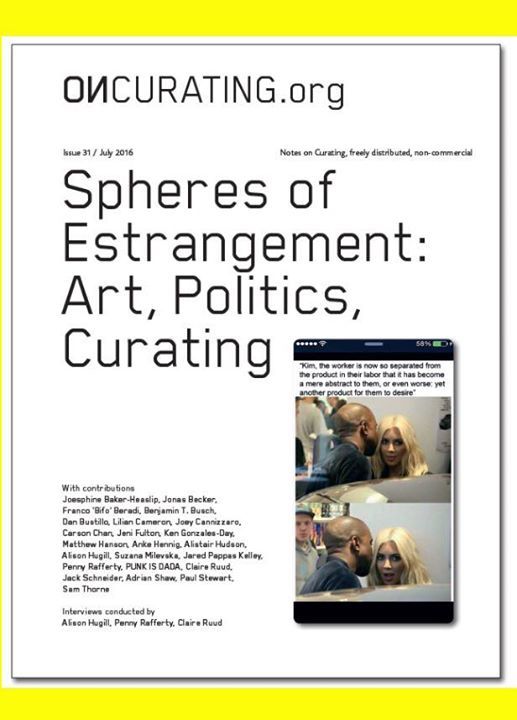In the latest issue of Oncurating 31: Spheres of Estrangement: Art, Politics, Curating the editors examine the idea of estrangement as an instrument for curating as well as means for artistic expression. In the essay Estrangement A Retro-Vision for 2016, Anke Hennig suggests: ‘The fascination with this line of thought is its inherent ambiguity. Estrangement is both an attempt to get rid of alienation and a strategy to profit from alienation. It expresses this very tension.’
From this vantage one considers the act of curating as estranging—perhaps affirming a Proustian refrain ‘not in seeking new landscapes, but in having new eyes.’ In splitting from the thing itself, spheres of estrangement offer a means for expressing this tension while at the same time making it produce (often problematic). Similarly: this casts the artist as a vocation of perpetual estrangement—and perhaps why artists seem to proliferate to an extent that there is almost no question between artist and non—as an endeavor borne from the tension of capitalizing on estrangement while similarly disappearing into it.
In a conversation between Penny Rafferty and Franco ‘Bifo’ Berardi in Society’s Richer Yet She’s Thin as a Rake they consider this idea of artist as a profession that also estranges. Excerpted below:
Penny Rafferty: But then if you assert yourself into the position of the artist, you put yourself into the utmost position of precariousness.
Franco ‘Bifo’ Berardi: Yes, the condition of the artist is the most extreme manifestation of the precarious worker, and it’s competiveness, but it’s also freedom from slavery, from salaried work.
PR: I see the romanticization of the artist and yes, I think some people become artists to avoid capitalist slavery, but how does this fit into the idea of the erotic?
FB: Ahh, yes, well this is another problem. When I was here before (Berlin, Germany), in May 2011, I was speaking to someone who told me that 24% of young Germans wanted to be artists according to some newspaper. Naturally, they didn’t know what being an artist is like; they may think it’s like being Michael Jackson and being very rich, etc. But this statistic came true, the art academies are booming, and becoming an artist is sort of possible for all in the generation of the precarious worker. Essentially, this choice to become an artist is the choice to escape the boredom of work. This sentiment is strong in the self-perception of the artist. It has always been this way. It’s the bohemian attitude.
PR: In my eyes, becoming an artist is to change the rules, to slow down or eradicate the goals set to us by society; when we should go to school, when we give birth, when to die, etc.—It’s an act of rebellion.
FB: Yes, which is why being an artist is saying I don’t want to be a slave, a slave of life, a slave of salaried work, but previously when I asked your opinion, you said you thought people wanted to be artists because they needed a new form of language?
The entirety of this interview can be found here.
